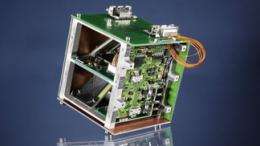420 magical seconds in space

(PhysOrg.com) -- A new tool to calculate the orientation of a satellite with respect to the Earth, developed by EPFL students, will be on board a European Space Agency rocket scheduled to launch in March 2012. This will be an opportunity to test the tool in ideal microgravity conditions.
An elegant invention, developed by a group of ten EPFL students, will take flight next March on a rocket launched in Sweden. The product of more than a year’s work, it was accepted by the European Space Agency (ESA) after a lengthy selection process.
The project offers a new method to calculate the orientation of a satellite with respect to the Earth. This is a very important function, because whether the goal is telecommunications or taking pictures, satellites need to be pointed precisely towards Earth to work optimally.
The tool – called the Gravity Gradient Earth Sensor - measures the gradient of gravitational forces, in other words, the rate at which gravity decreases as you go further away from the center of the Earth. Very thin, precise sensors developed in EPFL’s Microsystems for Space Technologies Lab in Neuchâtel can capture changes as small as a tenth of a nanometer, the order of magnitude of a single atom.
Finding the Earth
The problem is simple: as was experienced by SwissCube, a satellite launched into orbit can end up tumbling around in all directions. How can it position itself? The solution is instinctive: find the Earth, and orient itself accordingly!
“Up to now, optical sensors were used to find Earth using infrared emissions,” explains Hervé Meyer, a scientist in EPFL’s Space Center. “But that’s a very sensitive technique, which must be installed on the exterior of the satellite. It’s thus very exposed and very fragile. The tool we’re developing is protected, inside the satellite.”
It’s impossible to test the precision of the new tool under terrestrial conditions, because the effects of gravity are too strong. It can only be tested in microgravity conditions, where the forces of the gravity field still exist, but are much weaker. To attain these conditions, the tool can be placed on a rocket launched into a parabolic flight trajectory. The rocket that will carry the four test sensors, enclosed in a ten-centimeter cube resembling the SwissCube picosatellite, will fly up to an altitude of 100 km.
Concrete and rewarding
The rocket’s flight will last about 13 minutes, but it will only be in microgravity conditions for about 420 seconds. The team will have to make the most of this valuable time to take all the data they need. In particular, they’ll be measuring the effects of acceleration and rotation.
“It’s a very concrete and rewarding project that taught students a lot not only about how an institution like ESA functions, but also about how to work in a multidisciplinary team, with people coming from fields like microengineering, electronics and materials science,” notes Muriel Richard, senior scientist in EPFL’s Space Center. The Space Center offers regular technical and logistical guidance for student projects in space technologies.
Provided by Ecole Polytechnique Federale de Lausanne




















